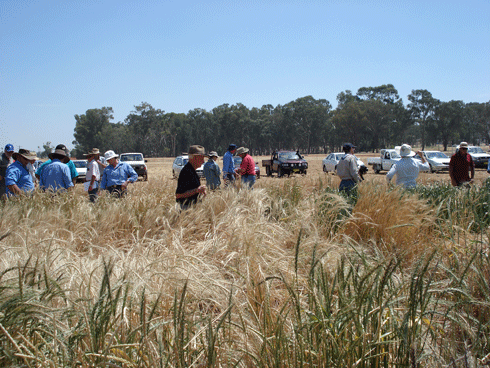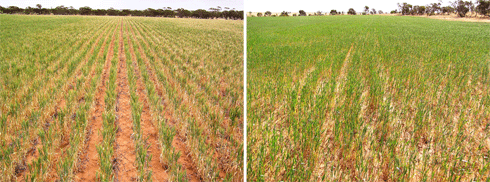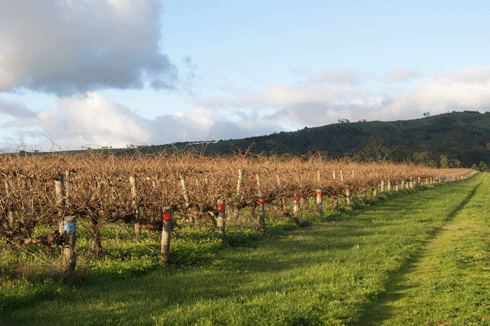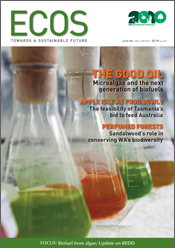
|
Published: 20 December 2010
Organically grown research
As sales of Australian-grown organic produce increase, organic farmers are calling for increased research into the sector. What science is happening, and what is needed?
In the past two years, retail sales of Australian organic produce have grown more than 50 per cent (from $623 million to $947 million), and were expected to pass $1 billion for the first time in 2010, according to the 2010 Australian Organic Market Report. To put this in context, Australian organic sector sales make up just one per cent of total sales of agricultural products, but compare well to mid-earning export industries such as seafood and nuts.
Factors driving the growth of the organic sector include consumer demand, drought, rising costs of conventional farming inputs, a desire to reduce the use of chemicals for the immediate health of people on the land, and downstream accumulation of environmental toxins.
Some key organic industry players believe peer-reviewed R&D in organics does not reflect either the sector’s contribution to the Australian economy, or its potential role in protecting and conserving the health of the environment.
Ms Katherine DiMatteo, President of the International Federation of Organic Agriculture Movements, says organisations representing growers, processors and retailers in the organic sector are adopting land stewardship goals that go beyond their traditional advocacy roles.
‘It’s not just about having organic food or other organic non-food products in your supermarket,’ she says. ‘It’s about really changing the way that we interact with our environment, especially through farming.’
Dr Paul Kristiansen, a researcher at the University of New England with 15 years experience in organic agriculture, co-authored the organic market report for industry body Biological Farmers of Australia. The report was based on voluntary survey responses by organic farmers, processors, retailers and wholesalers. Dr Kristiansen says the sector’s growth throws research funding into sharp relief.
‘Domestic supply is falling well short of demand, and it is not really being matched by public research or research funding,’ he says.
‘There is a lot of private investment and research into organic markets going on at the moment, and there is a fair amount of enthusiasm at how exciting it all is – people are seeing opportunities and getting in with whatever ‘muck and magic’ they can. But I like my agriculture to be science based, whether it’s organic or not.’
Depending on the commodity sector, organic farmers pay an obligatory research and development levy. Most organics research in Australia has been carried out under the auspices of the Rural Industries Research and Development Corporation (RIRDC). A 2003 RIRDC study found the total investment in organic agriculture R&D fell well short of the amount collected from organic farmers (and matched by Commonwealth contributions) in 2000–01.
Organics research in Australia
Dr Brian Keating leads the Sustainable Agriculture Flagship at CSIRO. His team is measuring soil carbon and the impacts of farming practices on soil carbon reserves (including specific inputs such as biochar). They are also developing strategies to optimise the beneficial microbial functions in farming systems – including research into microbial inoculants, minimum tillage and stubble retention practices. All of these research developments have the potential to benefit organic farming management systems.
While Dr Keating makes it clear that the organisation doesn’t advocate particular farming systems, he does say that much of CSIRO’s research is relevant to organic farmers.

|
|
Farmers and spelt processors inspect trials of organic spelt at a NSW Department of Industry and Investment research site at Yanco. Credit: Robyn Neeson
|
‘Understanding how these systems function enables a broad spectrum of management types, from those in conventional and emerging practice, as well as those that will be designed by future farmers responding to different circumstances,’ he explains.
‘Organic farming is part of the picture, as we see it, for increasing the sustainability of Australia’s agriculture sector. However, we approach it as an issue of farmer and consumer choice, and not a panacea for every challenge facing Australian or global agriculture.’
CSIRO entomologist Dr Vadakattu Gupta recently completed a detailed study of the diversity and activity of soil microbes in broadacre organic farming systems in southern Australia’s rain-fed agricultural region. Soil microbial diversity is an important issue in organic systems, which aims to increase beneficial soil microbial activity through the use of organic fertilisers and inputs, thereby increasing the rate of nutrient cycling.
‘There is a perception that you will automatically benefit from increased microbial diversity and improved biological functions, simply by implementing organic farming systems,’ says Dr Gupta.
His study showed that enhanced soil microbial communities and biological processes might not be a definitive feature of broadacre organic systems.
‘Organic farming is a broad term, and the actual individual farming practice differs between regions and soil types,’ he says.
The long-term view
At Charles Sturt University’s E.H. Graham Centre for Agricultural Innovation, Ms Robyn Neeson is trialling optimised quality and yield for spelt and other speciality grains under organic production. She says there are gaps in organic research in Australia.
‘Part of the problem is that organic systems are often quite complicated,’ says Ms Neeson, liaison officer for organic farming at the Centre. ‘We need long-term research projects that look at longer rotations, and that compare organic and conventional side by side, rather than just single variable studies.’

|
| Waikerie, South Australia. At left, wheat crop grown conventionally; at right wheat on a different farm in the same district has been grown organically. |
There is a valid question, though, about whether publicly funded research should be directed to specific farming systems, or be more broadly relevant. CSIRO’s research investment processes, for example, delineate publicly funded research – which can be drawn on by broad sectors of Australia’s industry and community – from research the industry could do on its own behalf.
Dr Keating acknowledges we need better links between mainstream R&D and the interests of organic sector, given the potential for science to inform sustainability in the organic sector, as in any other sector. However, he says it is important to remember that organic and conventional agricultural systems can be unsustainable if designed and managed inappropriately.
‘The issues are complex and long-term, and this represents a big challenge for current short-term models of agricultural R&D funding,’ he says.
Adelaide University researcher Mr Chris Penfold is also worried about the short-term nature of funding for organic research. Mr Penfold is supervising the viticulture-based trial of PhD student Luke Johnston at McLaren Flat, south of Adelaide.
The trial, which is funded by the Grape and Wine Research and Development Corporation, compares high and low-input conventional systems, a biodynamic system, and an organic system. It includes a compost variable, an important component, due to the recent relative affordability of large-scale compost application for nutrient input on organic farms.
Mr Penfold conducted a similar pioneering study that ended in 1996, and is not aware of any other long-term, broad-acre farming trials in Australia comparing systems in this way. Current funding of the McLaren Flat trial will run out at the end of 2010, its third year. But, Mr Penfold believes that six to eight years are necessary, to ‘get valid data and see what the long-term impacts are, particularly with soil data, including soil microorganisms and invertebrate numbers.’
In August 2010, the Organic Federation of Australia (OFA), the industry peak body, established the Environmental Research and Education Trust to support research into the sector, hoping to encourage increased investment in organics R&D.
Mr Andre Leu, a far-north Queensland fruit grower and chair of OFA, says government-funded agricultural research does focus on relevant indicators for organic farming.
‘But, there is a scarcity of comparison trials between organic farming systems and conventional systems,’ he says. ‘Peer-reviewed, long-term comparison studies conducted in other countries show that the real differences between conventional and organic systems emerge after at least five years. This is why there is a need for long-term trials to develop useful data.’
Dr Kristiansen agrees that more long-term trials are needed.
‘The time scale issue is a problem that is common to agricultural research in general, but it is perhaps more acute in organic agriculture,’ he says.
‘Funding tends to be for three or four years, whereas in organic agriculture you are dealing with complex systems, in which effects accumulate over 10 to 20 years. Short-term plot trials, and I do a fair bit of that, don’t always show the potential deeper benefits in terms of what’s happening in the carbon or reduction in external inputs.’




